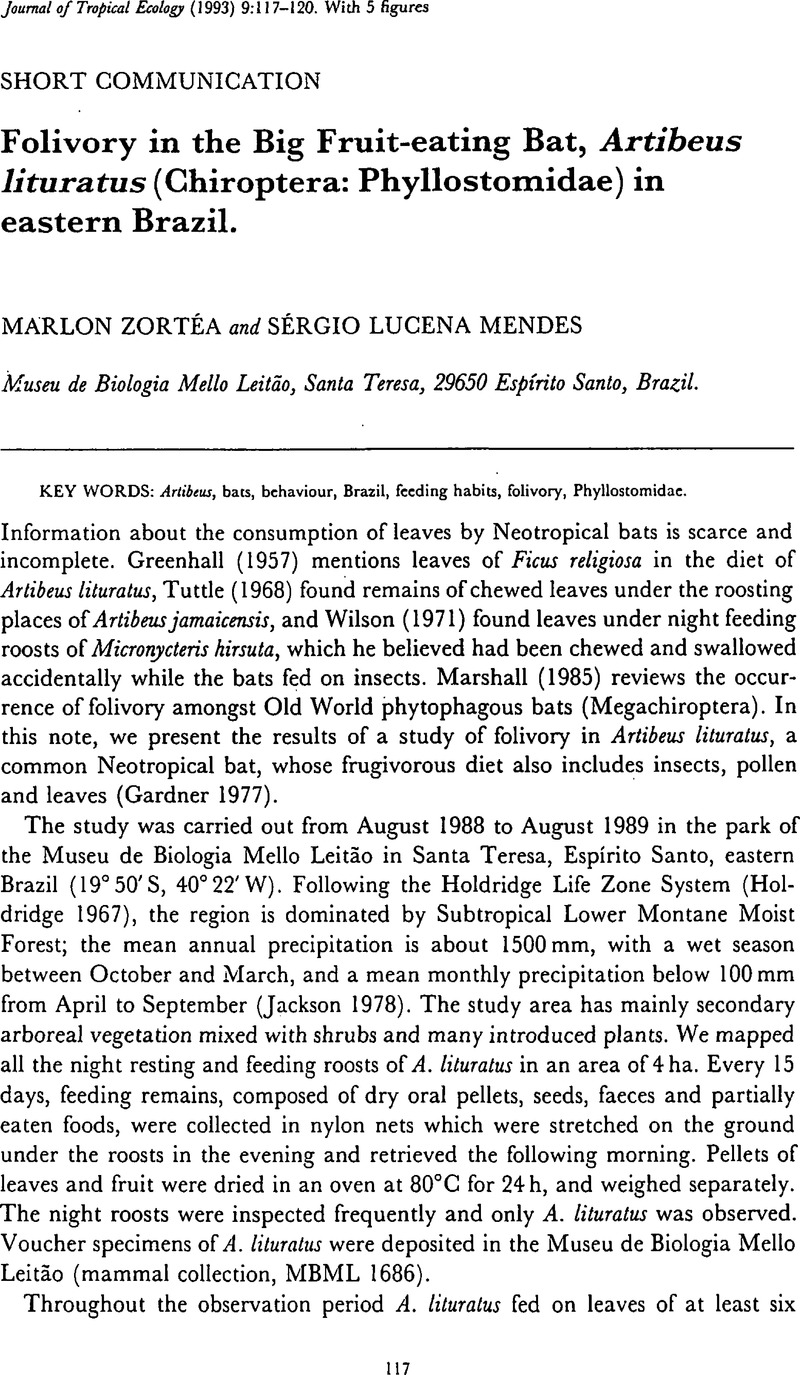Crossref Citations
This article has been cited by the following publications. This list is generated based on data provided by Crossref.
Kalko, Elisabeth K. V.
Herre, Edward Allen
and
Handley, Charles O.
1996.
Relation of fig fruit characteristics to fruit‐eating bats in the New and Old World tropics.
Journal of Biogeography,
Vol. 23,
Issue. 4,
p.
565.
Delorme, M.
and
Thomas, D. W.
1996.
Nitrogen and energy requirements of the short-tailed fruit bat (Carollia perspicillata): fruit bats are not nitrogen constrained.
Journal Of Comparative Physiology B,
Vol. 166,
Issue. 7,
p.
427.
KALKO, ELISABETH K.V.
HANDLEY, CHARLES O.
and
HANDLEY, DARELYN
1996.
Long-Term Studies of Vertebrate Communities.
p.
503.
Korine, Carmi
Izhaki, Ido
and
Arad, Zeev
1999.
Is the Egyptian fruit-bat Rousettus aegyptiacus a pest in Israel? An analysis of the bat's diet and implications for its conservation.
Biological Conservation,
Vol. 88,
Issue. 3,
p.
301.
Elangovan, V.
Marimuthu, G.
and
Kunz, Thomas H.
2001.
TEMPORAL PATTERNS OF RESOURCE USE BY THE SHORT-NOSED FRUIT BAT,CYNOPTERUS SPHINX(MEGACHIROPTERA: PTEROPODIDAE).
Journal of Mammalogy,
Vol. 82,
Issue. 1,
p.
161.
Bernard, Enrico
2002.
Diet, activity and reproduction of bat species (Mammalia, Chiroptera) in Central Amazonia, Brazil.
Revista Brasileira de Zoologia,
Vol. 19,
Issue. 1,
p.
173.
Passos, Fernando C.
and
Graciolli, Gustavo
2004.
Observações da dieta de Artibeus lituratus (Olfers) (Chiroptera, Phyllostomidae) em duas áreas do sul do Brasil.
Revista Brasileira de Zoologia,
Vol. 21,
Issue. 3,
p.
487.
Prem Anand, A. Alwin
and
Sripathi, K.
2004.
Digestion of cellulose and xylan by symbiotic bacteria in the intestine of the Indian flying fox (Pteropus giganteus).
Comparative Biochemistry and Physiology Part A: Molecular & Integrative Physiology,
Vol. 139,
Issue. 1,
p.
65.
Giannini, Norberto P.
and
Kalko, Elisabeth K. V.
2004.
Trophic structure in a large assemblage of phyllostomid bats in Panama.
Oikos,
Vol. 105,
Issue. 2,
p.
209.
Nelson, Suzanne L.
Kunz, Thomas H.
and
Humphrey, Stephen R.
2005.
Folivory in Fruit Bats: Leaves Provide a Natural Source of Calicum.
Journal of Chemical Ecology,
Vol. 31,
Issue. 8,
p.
1683.
Bravo, Adriana
Harms, Kyle E.
Stevens, Richard D.
and
Emmons, Louise H.
2008.
Collpas: Activity Hotspots for Frugivorous Bats (Phyllostomidae) in the Peruvian Amazon.
Biotropica,
Vol. 40,
Issue. 2,
p.
203.
Rex, Katja
Czaczkes, Benjamin I.
Michener, Robert
Kunz, Thomas H.
and
Voigt, Christian C.
2010.
Specialization and omnivory in diverse mammalian assemblages.
Écoscience,
Vol. 17,
Issue. 1,
p.
37.
Mendes, Poliana
Vieira, Thiago Bernardi
Oprea, Monik
Lopes, Sílvia Ramira
Ditchfield, Albert David
and
Zortéa, Marlon
2010.
O conhecimento sobre morcegos (Chiroptera: Mammalia) do estado do Espírito Santo, sudeste do Brasil.
Papéis Avulsos de Zoologia,
Vol. 50,
Issue. 22,
p.
363.
Ruiz-Ramoni, Damián
Muñoz-Romo, Mariana
Ramoni-Perazzi, Paolo
Aranguren, Yani
and
Fermin, Gustavo
2011.
Folivory in the Giant Fruit-Eating BatArtibeus amplus(Phyllostomidae): A Non-Seasonal Phenomenon.
Acta Chiropterologica,
Vol. 13,
Issue. 1,
p.
195.
Clulow, Simon
and
Blundell, Adam T.
2011.
Deliberate Insectivory by the Fruit BatPteropus poliocephalusby Aerial Hunting.
Acta Chiropterologica,
Vol. 13,
Issue. 1,
p.
201.
Andrianaivoarivelo, RA
Jenkins, RKB
Petit, EJ
Ramilijaona, O
Razafindrakoto, N
and
Racey, PA
2012.
Rousettus madagascariensis (Chiroptera: Pteropodidae) shows a preference for native and commercially unimportant fruits.
Endangered Species Research,
Vol. 19,
Issue. 1,
p.
19.
Cordero-Schmidt, Eugenia
Medeiros-Guimarães, Maricélio
Vargas-Mena, Juan Carlos
Carvalho, Bruna
Ferreira, Rodrigo Lopes
Rodriguez-Herrera, Bernal
and
Venticinque, Eduardo M.
2016.
Are Leaves a Good Option in Caatinga's Menu? First Record of Folivory inArtibeus planirostris(Phyllostomidae) in the Semiarid Forest, Brazil.
Acta Chiropterologica,
Vol. 18,
Issue. 2,
p.
489.
Alves, Eveline de Cássia Batista de Almeida
Arandas, Maria Juliana Gomes
Lima-Junior, Nivaldo Bernardo de
Evêncio Neto, Joaquim
and
Santos, Katharine Raquel Pereira dos
2017.
ANÁLISE HISTOQUÍMICA DA LÍNGUA DE MORCEGOS FRUGÍVOROS NEOTROPICAIS (MAMMALIA - CHIROPTERA) COM RELATO DE PIGMENTAÇÃO EPITELIAL.
Ciência Animal Brasileira,
Vol. 18,
Issue. 0,
Rocha, Patrício A. da
Pereira, Arivania S.
Silvestre, Saulo M.
Santana, José Paulo
Beltão-Mendes, Raone
Zortéa, Marlon
and
Ferrari, Stephen F.
2017.
Consumption of leaves by Platyrrhinus lineatus (Chiroptera, Stenodermatinae): are these bats primarily frugivorous or broadly phytophagous?.
Zoology,
Vol. 121,
Issue. ,
p.
44.
Montoya-Bustamante, Sebastián
and
Zapata-Mesa, Natalya
2017.
Accidental consumption of Atta cephalotes (Hymenoptera: Formicidae) by Artibeus lituratus (Chiroptera: Phyllostomidae).
Mammalogy Notes,
Vol. 4,
Issue. 1,
p.
25.



